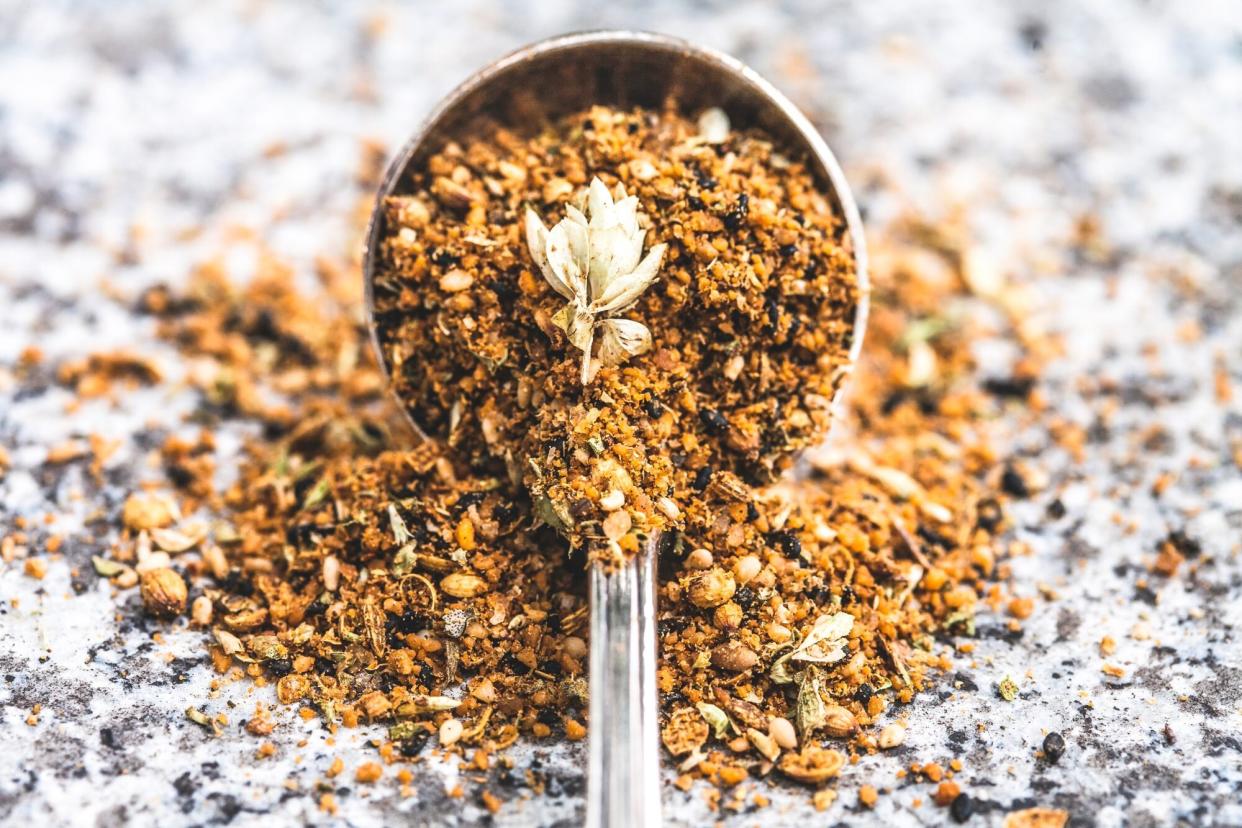What Is Dukkah? Here's How to Make and Use This Fragrant Middle Eastern Spice Blend

Enrique Diaz / GETTY IMAGES
TABLE OF CONTENTS
On This Page
What Is Dukkah?
How to Use Dukkah
How to Make Dukkah
If you're looking to expand your culinary repertoire, set your sights on dukkah. Also spelled dukkha, duqqa, du'ah, or do'a, this fragrant, earthy Middle Eastern seasoning mix lends texture, crunch, and plenty of oomph to proteins, salads, rice, and more.
Originating in ancient Egypt, dukkah mixes made use of cumin, coriander, and salt, which were readily available on the spice routes that connected the East and West—eventually becoming a Middle Eastern staple. Lately, it's been making strides stateside, turning up on restaurant menus; several small companies have even started sharing their takes on dukkah. To learn more about dukkah, including its key ingredients and how it is used, we reached out to two food professionals who offer unique interpretations of this enduring spice blend.
Related: 7 Spice Blends That Are Worth Buying
What Is Dukkah?
Traditionally a mixture of nuts, seeds, and spices, dukkah is part of myriad food traditions across cultures. The word dukkah comes from the Arabic word "to pound" or "to crush," referring to the old-world method of using a mortar and pestle to pound or crush the ingredients.
"The classic version typically contains hazelnuts, sesame seeds, and coriander seeds, but like most spice blends, it vastly varies from regions and family recipes," says Leetal Arazi, the CEO and culinary director of New York Shuk, which she co-founded with her husband, Ron Arazi. The company specializes in handcrafted Middle Eastern pantry staples, many reminiscent of their collective Israeli and Middle Eastern roots—including dukkah.
Middle Eastern variations are all over the map. "Every recipe is different, and in traditional markets, you will find a variety of blends, depending on the family or vendor," says Alison Wu, the co-founder, of Ami Ami, a Portland, Ore.-based company specializing in dukkah-inspired spice blends.
Variations
Each company offers its own spin on this age-old mix. New York Shuk's dukkah, for example, showcases pistachio nuts, sesame seeds, coriander seeds, pumpkin seeds, and za'atar (the culinary herb, not the blend). Toasting the ingredients, then pounding them together, brings out the rich flavors and oils.
So, why pistachios, instead of tried-and-true hazelnuts? "I'm obsessed with all things pistachio, so I knew if we were going to add dukkah to our line it would include pistachios," says Arazi. The company plans to expand its flavors down the road.
Ami Ami offers three riffs on dukkah: Spicy (a blend featuring hazelnuts, pepitas, coriander, and maras peppers, among other ingredients, with a slow-building heat and umami punch), Savory (an herbaceous blend including pine nuts, fennel, sumac, and lemon peel), and Floral (an aromatic, sweet interpretation, with pistachios, rose, sesame, and cardamom). "The trio of toppings really works diversely across a variety of flavor profiles," says Wu. They also have a coarser texture than traditional dukkah, which tends to be more pulverized or powdered, she says.
How to Use Dukkah
In the Middle East, dukkah is commonly used as a condiment; bread (like the flatbread khubz) is dunked in a small bowl of olive oil, then dipped into a small bowl of dukkah. It sometimes appears on tables during Eid al-Fitr, the three-day festival celebrating the conclusion of the Ramadan fast.
But why stop there when dukkah can elevate all kinds of everyday dishes? Essentially, it adds va-va-voom, says Arazi. "Dukkah is very much the equivalent of fairy dust. A little sprinkle here, a little sprinkle there, and it brings so much flavor and texture that it really is a pantry must-have," she says.
Sweet and Savory Toppings
The Ami Ami toppings are intended for finishing, explains Wu. She generously sprinkles the Floral mix on whipped ricotta toast, Savory on creamy cashew pasta primavera, and Spicy on creamy broccoli-spinach soup. "Salads, soups, eggs, grain bowls, yogurt, ice cream—the possibilities are endless," she says. "It's so delicious, you can even eat it straight from the jar!"
Arazi also flings the culinary doors wide open, using dukkah to jazz up salads and pasta salads or to create a crust on roasted fish, grilled meats, eggs, halloumi cheese, and tofu. She sprinkles it over roasted vegetables, hummus, labneh, and other soft cheeses, and uses it to garnish vegetable soups, like carrot or butternut squash.
Yogurt
And, like Wu, Arazi believes that dukkah and yogurt make a delicious duo. "While dukkah is a savory flavor, we find that it works well in both sweet and savory yogurt dishes," she says. She combines yogurt with chopped cucumbers and dill, then finishes it with dukkah and olive oil. On the sweet side, she likes yogurt with fresh fruit, dukkah, and a drizzle of honey or maple syrup or—her favorite—apricot jam.
Making Your Own
Another way to delight in dukkah? Try making your own version at home. Different iterations can be labor-intensive, with some ingredients requiring different roasting or toasting times and chopping techniques—but maybe that's part of the exploration, says Wu. "You can play around with your favorite selection of spices, seeds, and nuts to make something uniquely your own," says Arazi.

